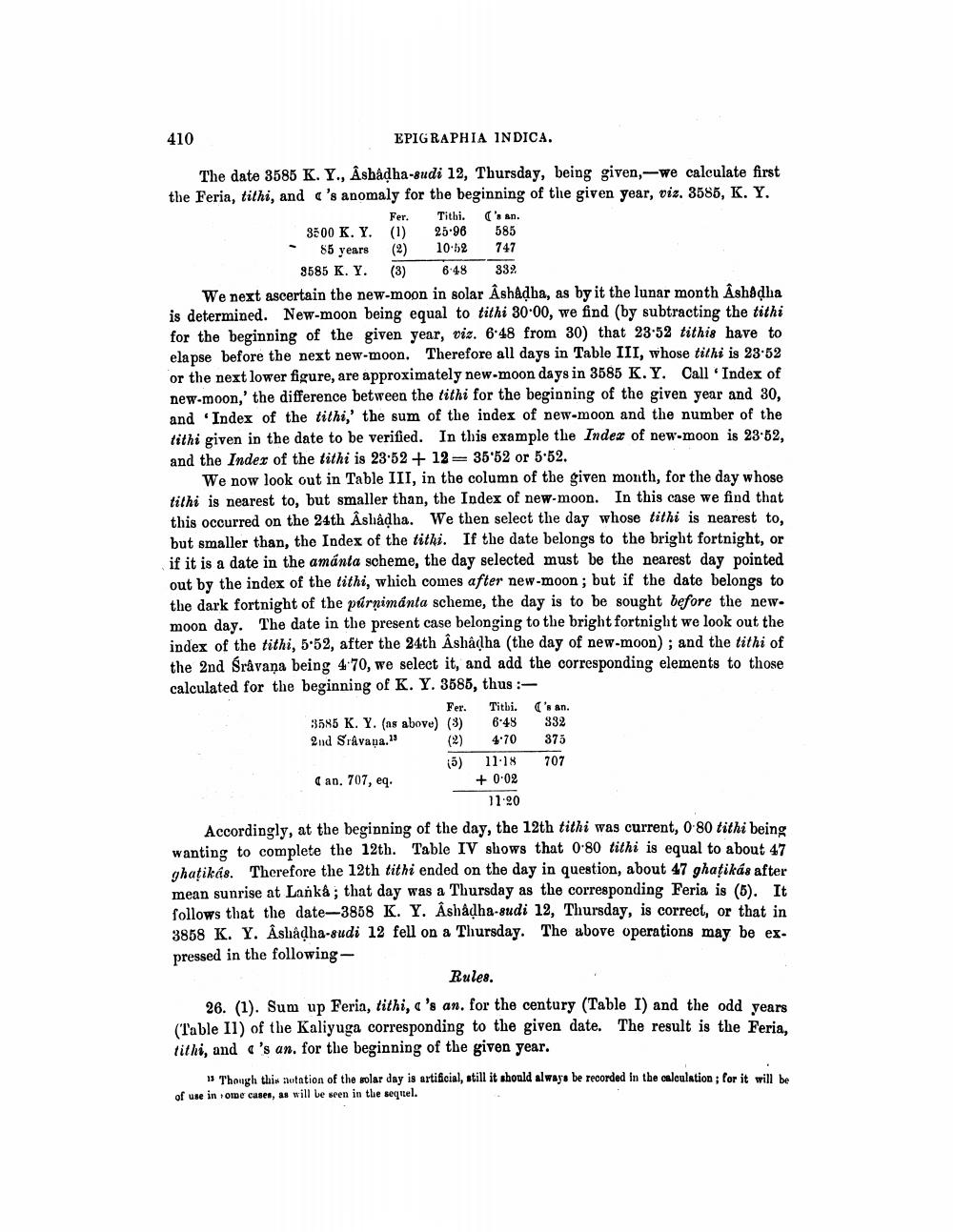________________
410
EPIGRAPHIA INDICA.
The date 3585 K. Y., Ashadha-sudi 12, Thursday, being given,--we calculate first the Feria, tithi, and c's anomaly for the beginning of the given year, viz. 3585, K. Y.
Fer. Titbi. C's an. 3500 K. Y. (1) 25.96 585
$5 years (2) 10-52 747
9585 K. Y. (3) 6-48 332. We next ascertain the new-moon in solar AshAdha, as by it the lunar month AshAdha is determined. New-moon being equal to tithi 30.00, we find (by subtracting the tithi for the beginning of the given year, viz. 6-48 from 30) that 23.52 tithis have to elapse before the next new-moon. Therefore all days in Table III, whose tithi is 23.52 or the next lower figure, are approximately new-moon days in 3585 K. Y. Call Index of new-moon,' the difference between the tithi for the beginning of the given year and 30, and Index of the tithi,' the sum of the index of new-moon and the number of the tithi given in the date to be verified. In this example the Index of new-moon is 23:52, and the Inder of the tithi is 23.52 + 12 = 35'52 or 552.
We now look out in Table III, in the column of the given month, for the day whose tithi is nearest to, but smaller than the Index of new-moon. In this case we find that this occurred on the 24th Ashadha. We then select the day whose tithi is nearest to. but smaller than, the Index of the tithi. If the date belongs to the bright fortnight, or if it is a date in the amánta scheme, the day selected must be the nearest day pointed out by the index of the tithi, which comes after new-moon; but if the date belongs to the dark fortnight of the párnimánta scheme, the day is to be sought before the newmoon day. The date in the present case belonging to the bright fortnight we look out the index of the tithi, 5.52, after the 24th Ashâdha (the day of new-moon); and the tithi of the 2nd Sravana being 4:70, we select it, and add the corresponding elements to those calculated for the beginning of K. Y. 3585, thus :
Fer. Titbi. ('n an. 3585 K. Y. (as above) (3) 6-48 332 2nd Sravaua." (2) 4.70 375
15) 1118 707 Can. 707, eq.
11-20 Accordingly, at the beginning of the day, the 12th tithi was current, 0.80 tithi being wanting to complete the 12th. Table IV shows that 0.80 tithi is equal to about 47 ghaţikás. Therefore the 12th tithi ended on the day in question, about 47 ghaţikás after mean sunrise at Lanka; that day was a Thursday as the corresponding Feria is (6). It follows that the date-3858 K. Y. Ashadha-sudi 12, Thursday, is correct, or that in 3858 K. Y. Åshadha-sudi 12 fell on a Thursday. The above operations may be expressed in the following
Rules. 26. (1). Sum up Feria, tithi, a's an, for the century (Table I) and the odd years (Table 11) of the Kaliyuga corresponding to the given date. The result is the Feria, tithi, and «'s an, for the beginning of the given year.
+ 0.02
1 Though this nutation of the solar day is artificial, still it should always be recorded in the calculation ; for it will be of use in ome cases, as will be seen in the sequel.




